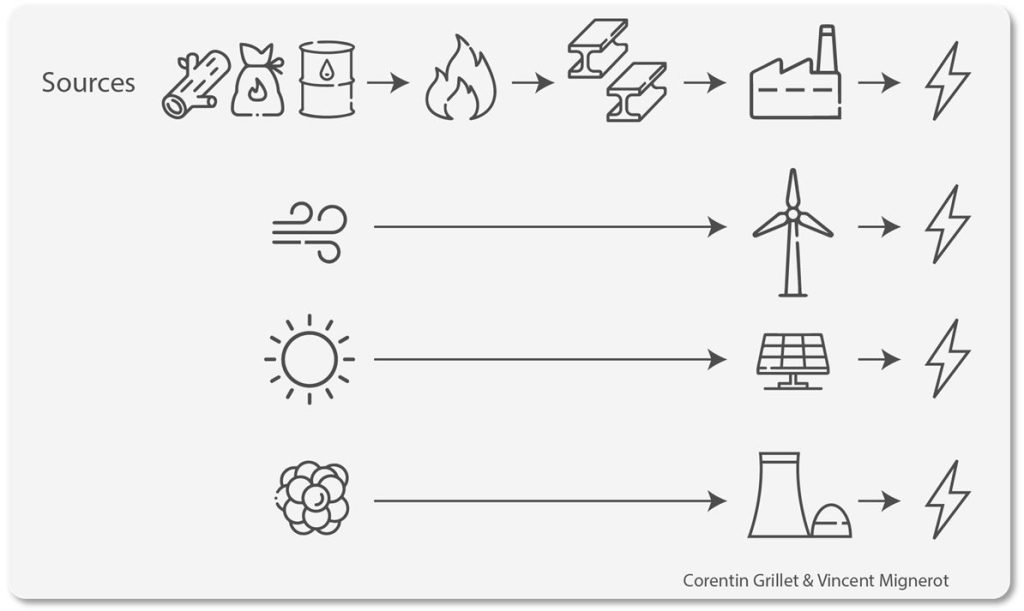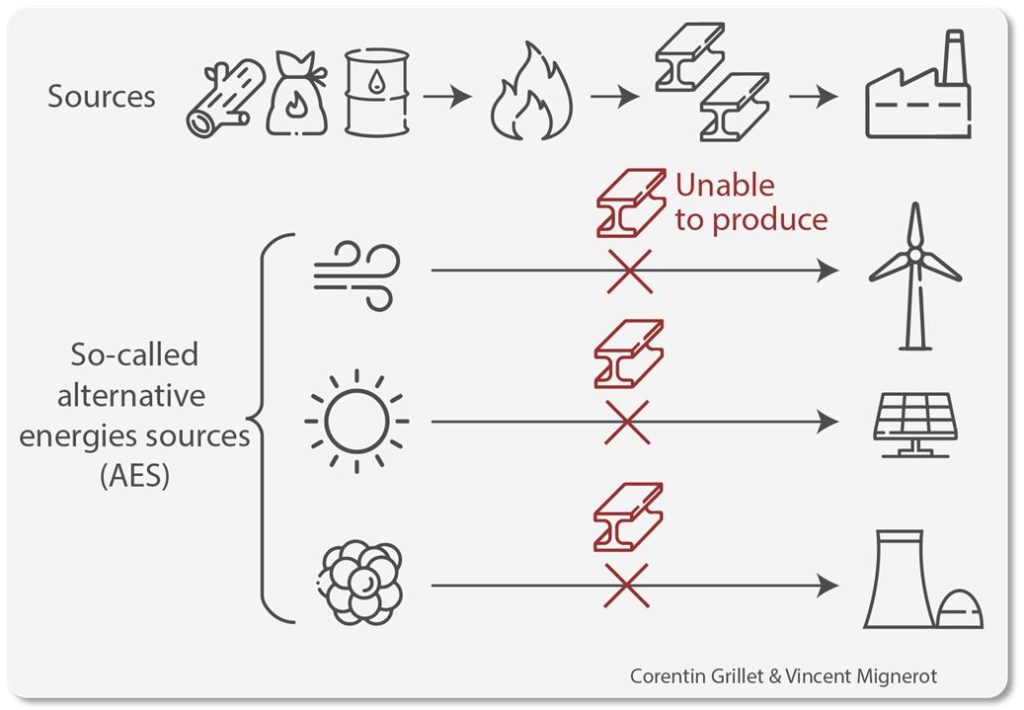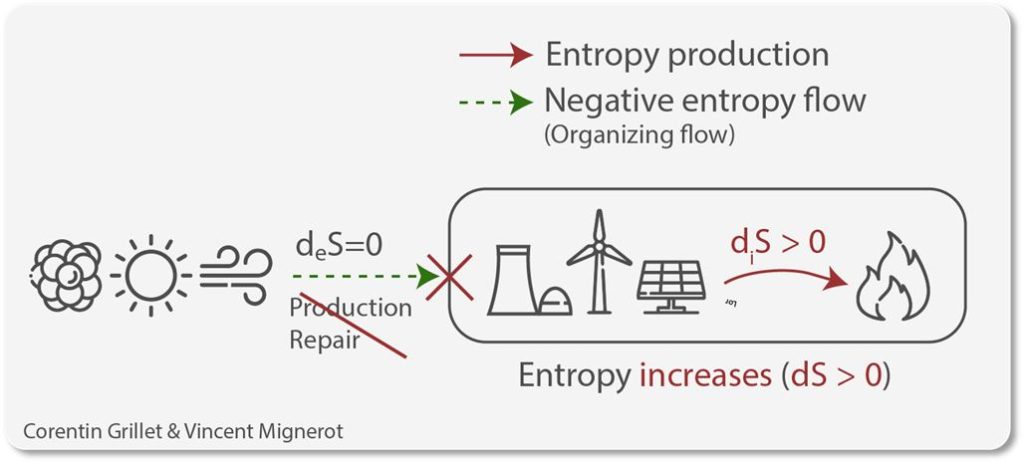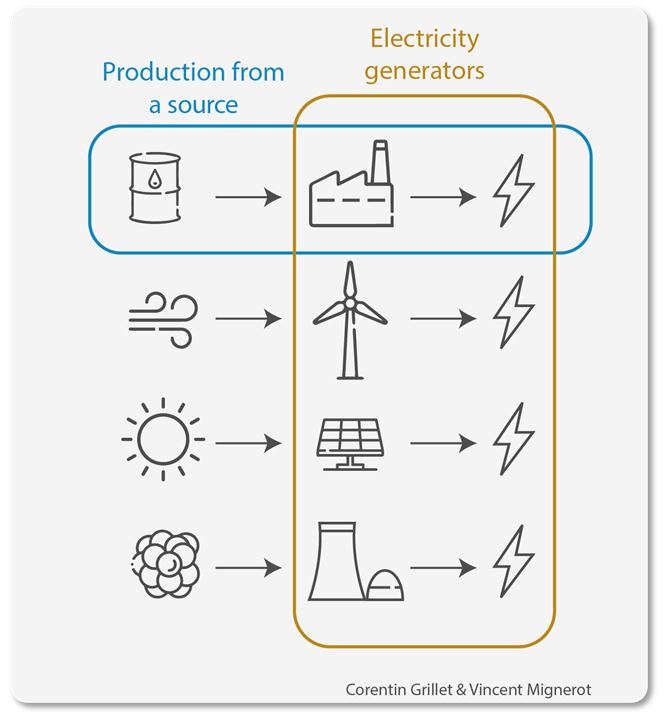This essay takes up and extends an analysis of the ambitions of the energy transition presented during the conference entitled “L’erreur fondamentale de la transition”, held in Lausanne in December 2022, at the annual Switzerland ShiftersDay. The intervention questioned the conceptualization of energy transition, given possible inaccuracies, or errors in the categorization of reality. It is not certain that the energy contained in the wind, solar radiation, or atoms is equivalent to hydrocarbon energy for human societal needs. Although all energies are theoretically convertible into one another, the assumption that any type of energy can always be replaced by another is likely to prove false. An energy transition based on the substitution of energies would then be inconceivable.
____
1. Humanity and energy
Human societies are organized around energy.
There is energy in the wind, solar radiation, and atoms.
Therefore, human societies can organize themselves by using the wind, solar radiation, and atoms.
This is the reasoning behind the conceptualization of the energy transition, which aims to free thermo-industrial societies from their dependence on coal, oil, and gas. Of course, the various forms of energy that wind turbines, photovoltaic panels and nuclear power plants convert into electricity to provide services. However, the original form of energy contained in the wind (kinetics), solar radiation (electromagnetic), or atoms (nucleon bonding force) is different from those present in hydrocarbons (chemical energy). The processes and techniques for harnessing these energies (extraction, conversion) are not identical, and the possibility of substituting one with anotherto supply thermo-industrial societies is not obvious.
By way of comparison, photosynthetic organisms, whose vital energy source is solar radiation, would be condemned to die away due to lack of light. They are in fact incapable of substituting the energy coming directly from the Sun with that contained, for example, in the wind or the force of water flowing down a river. Moreover, organic matter (the matter “made” by life) is humanity’s vital source of energy: we must consume living organisms to satisfy the needs of our bodies. However, if we were to run out of edible organic matter, we would be unable to feed ourselves with wood, peat, or coal, even though-they wood, peat, or coal;is also made of organic matter and contains energy. Although solar radiation, wind, and the force of water, wood, peat, or coal contain energy, a particular relationship between the quality of the energy present in an environment and, the properties of the systemsdetermine whether these systems can take advantage of these energies.
To assess the conditions for achieving an energy transition through energy substitution, we need to assess and rank the characteristics of the different energy forms, in order to understand their compatibility with the different forms of human societies in general, and thermo-industrial societies in particular [1].
1.1. Humanity’s vital energy source
Organic matter enables at least two types of reactions that can generate transformationsusefultomankind: chemical reaction and exothermic reaction (which releases energy and gives off heat through combustion). It is because humans consume edible organic matter (every organism edible by humans), that they maintain their metabolic functions, by chemically breaking down the complex molecules contained in carbohydrates, lipids, and proteins. Humanity’s existential dependence on food is total. To exist, humanity must draw on organic matter, which constitutes its solesource of vital energy.
1.2. Humanity’s auxiliary energy sources
In addition to food, humanity has developed the ability to draw energy directly from organic matter in the form of biomass (wood, charcoal, peat, fats, or oils from animals or plant, etc.) and/or hydrocarbons (coal, oil, gas). Thanks to the exothermic reaction due to the combustion of biomass and hydrocarbons, it brings supplemental enablers to human life than just food alone: heat to fight the cold, to cook food, to melt metals, and make tools, or machines, etc. However, the existence of humanity, as a species, is not strictly dependent on the combustion of organic matter in the form of biomass, or hydrocarbons. Humanity can draw, or not draw from these energy sources, they therefore constitute auxiliary energy sources(auxiliary = “which provides additional services”).
1.3. Humanity’s auxiliary energies
During its evolution, humanity has also acquired the capacity to capture the energy contained in the wind, solar radiation, atoms, kinetic energy of water, underground heat (geothermal energy), etc. However, it is not possible to draw directly (by its labor force alone) from these energy types to obtain services. These energy types must first be extracted from the environment using dedicated infrastructures, then converted into useful energy (today most often electricity), also using dedicated infrastructures: wind turbines, photovoltaic panels, hydroelectric dams, geothermal power plants, etc. These infrastructures cannot be built using the energy they convert.They can only be builtusing humanity’s energy sources (food, biomass, hydrocarbons) and, often, involve auxiliary energy sources. The energy type contained in the wind, solar radiation, atoms, force of water, subsoil, etc., exploitation implies specific mineral extraction and building ofinfrastructure conversion.They constitute auxiliary energies.
2. Energy sources versus auxiliary energies
From an energy substitution perspective, it is required to differentiate the technological infrastructure that make it possible to exploit auxiliary energy sources (Figure 1), from thosemaking it possible to exploit auxiliary energy. So-called alternative energies sources (AES) are essentially extraction and conversion infrastructures required to harvestwind, solar radiation, ornuclear energy. The decarbonized energy mix of thermo-industrial societies is mainly envisionedusing wind turbines, photovoltaic panels and nuclear power plants.
AES authorizes energy transfers to human societies from their external environment, and these energy transfers fulfill certain needs of these societies. However, these transfers are qualitatively so different from the transfers carried out by infrastructures exploiting hydrocarbons that they may never be able to replace them.
Societies that exploit auxiliary energy sources in the form of hydrocarbons are qualified as “thermo-industrial societies”, because all transformation processes on which the services rendered to humanity by this type of society are initiated and maintained by an autocatalytic exothermic reaction: when a volume of organic matter combustion is initiated, the exothermic reaction generated leads to the combustion of the entire volume (combustible biomass, hydrocarbons), releasing its entire chemical energy potential. This “ripple effect” multiplies the initial effect, which can be minimal (a spark), without any new energy input.

Figure 1. The organization of a thermo-industrial society depends on a chain of transformations damped and maintained from a heat source: organic matter. [©Author’sdiagram]
The transfer of thermal energy that initiates and sustains the industrial processes of thermo-industrial societies is qualitatively different from other types of transfers, for example mechanical, radiation, nuclear, or electrical. No thermo-industrial process can be initiated, or maintained directly by the transfer of the kinetic energy of the wind, the energy of solar radiation, or the energy of atoms. Thermo-industrial societies carry out “thermosynthesis”: they carry out transformations using heat. Based on current knowledge and experiments, they do not have the capacity for “eolosynthesis”, “photosynthesis”, or “nucleosynthesis” (“radiosynthesis”). Thermo-industrial societies are not physically equivalent to possible “wind-industrial”, “photo-industrial”, or “nucleo-industrial” societies (Figure 2).

Figure 2. Thermo-industrial societies are capable of extracting and converting auxiliary energies. [© Author’s diagram]
For example, if the force of the wind propels a boat, or turns a windmill, this force is of no use in building them. Boats and mills are shaped using the labor force provided by food, if necessary supported by the heat from the combustible biomass used to melt the metal parts of these boats and mills. Likewise, the force of water does not allow the construction of a hydroelectric dam. Nor does the Sun’s electromagnetic radiation directly initiate any transformation leading to the founding of any industrial infrastructure. Uranium ore, independent of a nuclear power plant, is of no use. Neither wind, nor electromagnetic radiation, nor uranium atoms are combustible, nor provide heat by simply triggering combustion (Figure 3).

Figure 3. Comparison of thermo-industrial and wind/photo/nucleo-industrial processes. The thermo-industrial transformation chain cannot be transposed into industry models based on AES. [© Author’s diagram]
While energy science has determined that “everything is energy”, and that all forms of energy are potentially convertible into one another, it has also consistently confirmed, both theoretically and experimentally, that the conversions of each form of energy involved distinct processes. The transformation processes generated by mechanical, electromagnetic, nuclear, chemical, thermal, or electrical energy are qualitatively different and do not appear to be substitutable to supply energy to thermo-industrial societies, which are intrinsically dependent on a heat source. (Figure 4).

Figure 4. “So-called alternative energies sources” (AES) do not replace hydrocarbons: energy converters manufacturing depends on thermo-industry. [© Author’s diagram]
2.1. Alternative energies heat
If thermo-industrial societies intrinsically need a source of heat, they have gradually acquired the capacity to generate, from the conversion of wind energy, electromagnetic radiation, or atoms into electricity, heat capable of initiating and maintaining industrial processes (Figure 5). However, if heat is a form of energy that can be obtained immediately from hydrocarbons, obtaining it from AES involves several irreducible steps: initially extraction of energy from wind, solar radiation, or atoms, then conversion into electricity, and finally conversion of this electricity into heat. Each of these steps is dependent on the prior existence of different systems which are integrated into the thermo-industrial society itself [2]. Therefore,the heat generated from AES does not appear to be comparable to a heat source. It is a by-product of the overall process of energy extraction and conversion from wind, electromagnetic radiation, or atoms.

Figure 5. The presupposition of synergy and energy autonomy of the ENS: they would themselves produce the heat necessary for their repair (here, from the electricity they generate). [© Author’s diagram]
James Clerk Maxwell indicated, as early as 1876, that “The energy of a material system can only be estimated in a relative manner.” [3] Henri Poincaré continued, in 1902: “If the future state of the system is not entirely determined by its present state, it is because it further depends on the state of bodies external to the system. But then, is it likely that there exist among the parameters x which define the state of the system of equations independent of this state of the external bodies? And if in certain cases we think we can find them, is it not only because of our ignorance, and because the influence of these bodies is too weak for our experiment to be able to detect it? If the system is not regarded as completely isolated, it is probable that the rigorously exact expression of its internal energy will depend upon the state of the external bodies.” [4]
If the heat generated by AES constitutes a product of different industrial processes, it is relative to nothing for this industry. It is an internal energy of thermo-industrial societies. In the current state of knowledge, if the energy that thermo-industrial societies wish to obtain is an internalenergy to the physical system that they constitute and not a flow coming from the environment, then their functioning is condemned to deteriorate over time. The conditions for the organization are strict and limiting.
In physics, entropy designates a “state function, denoted S, which characterizes the state of “disorder” of a system” [5]. A state of low entropy characterizes a relatively [6] more “organized” system, while high entropy characterizes a relatively less“organized” system. Certain physical systems are endowed with particular properties: they are capable of stabilizing their internal organization as they are crossed by an energy flow. These systems are called “self-organized”. Thermo-industrial societies are self-organized systems: their internal activity stabilizes – depending on the conditions –theirorganization. As part of a reflection on the energy transition, it seems essential to take into consideration scientific knowledge on self-organization conditions (Read: Thermodynamics : from a simple engineering question to understanding irreversibility).
In 1971, Peter Glansdorff and Ilya Prigogine published the results of their research on the conditions for the existence of self-organized systems. The researchers indicate, on page 4 of their book Thermodynamic Theory of Structure, Stability, and Fluctuations [7] :
Peter Glansdorff and Ilya Prigogine remind us that, by default, the entropy of a system can only increase (Read:Thermodynamics: energy and entropy). On page 12, the authors specify:
“(a) The entropy is an extensive quantity. If a system consiste of several parts the total entropy is equal to the sum of the entropies ot each part. The change of entropy dS can therefore be split into two parts : the entropy production diS due to changes inside the system, and the flow of entropy deS due to the interaction with the outside world.
(…)
(b) The entropy production diS due to changes inside the system is never negative.”
Then, on page 13:
“For an isolated system, the entropy flow is by definition equal to zero and equations (2.1), (2.2), reduce to the classical formulation of the second law
diS ≥ 0 (isolated system)
This inequality states the entropy of an isolated system can never decrease.
(…)
So far, the system of interest may be open or closed. A closed system may exchange energy but not matter with the outside world.” (Figure 6)
In Chapter III of their research, the authors explore the conditions of the existence of self-organized systems, equipped with processes considered “reversible”. Certain systems, under certain conditions, are likely not to undergo entropy. They are then in a state described as “far from their thermodynamic equilibrium”. The experiments described show that “In many situations, the boundary conditions imposed on the system prevent it from reaching equilibrium.” The authors also considered that, under certain conditions of interaction with the environment, not only do certain systems see their state being maintained stable but that “entirely new properties” appear in these systems. This is the case of thermo-industrial companies, which can actively maintain industrial resource transformation processes.
In Chapter V, the authors further specify that for any non-isolated system (establishing interactions with its environment) considered stable, any increase in its entropy must be “compensated by a flow of [negative] entropy coming from outside the considered system”. Then, they complete their development in Chapter VII, by summarizing all the conditions considered necessary for the existence of stable systems endowed with new properties, which they call “dissipative systems”: the system must “exchange matter and energy with the outside world” to be kept “far from its state of thermodynamic equilibrium”, to stabilize its internal organization.

Figure 6. Entropy evolution of open and isolated systems. An open system can benefit from an incoming flow of negative entropy, and thus maintain its internal organization. An isolated system is doomed to produce entropy, it tends towards greater disorder. Mathematical notation formalism: I. Prigogine and P. Glansdorff (deS: entropy flow, diS: entropy production). [© Author’s diagram]
Peter Glansdorff and Ilya Prigogine’s work establishes conceptual distinctions that guard against confusion: the fact that thermo-industrial societies convert auxiliary energies into heat does not replace the irreducible necessity that the flow of entropy from which these societies need to organize themselves from their external environment. As we have seen, thermo-industrial systems constitute physical systems with different properties from possible “aeolo/photo/nucleo-industrial” systems. If “aeolo/photo/nucleo-industrial” systems capable of initiating and maintaining transformation processes directly from wind energy, solar, or nuclear radiation were to exist one day, they could be considered as open to these energies. They would benefit from it to maintain their organization, these energies would be real entropy flows, real organizing flows. Thermo-industrial societies, in the state of knowledge and experimentation, cannot initiate and maintain transformation processes using wind energy, solar radiation, or atoms. They constitute qualitatively different physical systems.
Historically, thermo-industrial societies, only had access to the different forms of energy in their external environment thanks to the exploitation of their only source of energy, organic matter, in particular thanks to the exploitation of auxiliary energy sources such as combustible biomass and hydrocarbons. Without these auxiliary energy sources, thermo-industrial societieswould not have the ability to build AES. On the criterion of access to an organizing flow, they then remain systems isolated from the energies coming from the wind, solar radiation, and atoms (Figure 7).

Figure 7. On the criterion of accessibility to a flow of negative entropy (organizing flow), the physical systems constituted by the aeolo/photo/nuclear industries constitute isolated systems, which tend towards greater disorder (see Figure 6). [© Author’s diagram]
According to the self-organization conditions specified by Peter Glansdorff and Ilya Prigogine, thermo-industrial societies also do not have the latitude to build and maintain AES, that is to say maintaining an openness to the auxiliary energies such as wind, solar radiation, or atoms, from their internal energy alone. Without heat obtained from an external resource (biomass, hydrocarbons, see Figure 8), the consumption of only the heat produced by a thermo-industrial society amounts to an increase in its entropy: the deterioration of its organization.

Figure 8. The entropy of aeolo/photo/nucleo-industrial systems can only decrease if they benefit from the opening of thermo-industrial systems to the organizing flow coming from hydrocarbons. [© Author’s diagram]
If the “entropy flow” approach, supported by the work of Peter Glansdorff and Ilya Prigogine, specifies the contours of possibilities for the transition, a simple “energy” approach would also point out the pitfalls and risks associated with the substitution of energies. Y. V. C. Rao, an engineer, recalls in his book Chemical Engineering Thermodynamics that “The first law of therrnodynamics relates the changes in the energy of matter under consideration with the energy exchanged as beat and work with its surroundings.” [8]
AES is a so-called low-carbon energy transfer pathway across the limits of the systems formed by thermo-industrial societies. These societies plan to use the energy conversion processes heat from wind, solar radiation, or atoms, to maintain other industrial processes, essential for the maintenance of AES. This heat generated by the AES is only a thermo-industrial industries internal energy, and the principles of thermodynamics show that the consumption of this heat does not compensate for the increase of the system internal entropy.Therefore the capacity of thermo-industrial societies to maintain and replace their AES can only decrease over time. The “net energy transfer across the system limits” can only tend to be reduced, as the systemmaintain its own organization via an internal “net energy change”.
In any case, the ambition of energy transition by substitution of energies is likely to be confronted with a scissors effect. Depending on its origin, internal, or external, energy is not always equivalent to an organizing flow. Without an energy source coming from their environment, or by consuming less and less of this source, by choice, or by constraint, thermo-industrial societies would be confronted with the progressive reduction in the availability of internal energy to counter the entropy. Their “disorganization” would increase over time.
According to the theoretical and experimental knowledge recalled here, the presupposition of energy substitution is confronted with limits, intrinsic to the properties of thermo-industrial societies and the qualities of the energies present in their environment.It is possible that believing in the substitution of any type of energy with another one, for the needs of human societies, finds its origin in the concealment of certain qualitative parameters, in favor of quantitative parameters, which are sometimes misleading.
3. Energy transition fundamental mistake
3.1. A lot does not mean possible
In Modern Economics Principles, Jean-Dominique Lafay, Joseph E. Stiglitz and Carl E. Walsh are concerned about the CO2concentration increase rate, as well as the global warming consequences [9].
They believe that “From an economic point of view, the principle of substitution is at the center of the problem. Slowing down emissions involves consuming less energy and replacing energy sources that produce large quantities [of CO2] – such as coal – with less polluting energy sources (natural gas), or which are not at all (hydroelectric power). To do this, we can consider increasing the costs of energy sources that produce greenhouse gases, for example by introducing a tax on different fuels based on their contribution to the increase in CO2. This would provide an incentive for companies to use energy sources that are less harmful to global warming.”(Read: La fiscalité environnementale)
For their part, transition theorists and engineers believe that substitution is based on increasing the performance of wind turbines (larger), photovoltaic panels (higher yields), on access to a larger, or more concentrated quantity of energy (nuclear fission, fusion). Overall, research focuses on obtaining the best possible energy returned on energy invested (EROI: the ratio between the amount of energy invested to obtain energy and the amount of energy obtained in return)[10].
The energy transition paradigm seems deeply imbued with dominant economic theories. These theories presuppose that the production of wealth depends on the adjustment of a few quantitative parameters, for example prices, and that there is no material constraint on development since resources, like capital and work, are always substitutable. In the current conceptualization of the transition, there is no a priori physical constraint either: it only requires the creation of more efficient machines so that carbon-free energies would replace carbon-based energies. However, there is no theory, nor any empirical observation which that would attest that efficient wind, solar radiation, or atoms AEScould initiate and maintain industrial processes.
Considering that thermo-industrial societies can move from the exploitation of energy sources to auxiliary energies implies the resolution of qualitative questions, which involves understanding the causal and logical links that thermo-industrial societies are maintaining with the different forms of energy present in their external environment[11].
3.2. Substitution bias
There are different ways of categorizing the realityentities, or grouping them into families defined by precise characteristics. For example, if we wonder to which animal category the “rabbit” belongs, beyond the category of “animal” it is either possible to classify them among “mammals”, or among “herbivores”.
One of the two categorizations is established based on the internal characteristics of rabbits (internal locus): rabbits are “vertebrates whose females breastfeed their young”. The second categorization is established based on the external characteristics of rabbits (external locus): to feed, rabbits must interact with things other than themselves, plants[12].

Figure 9. Two ways to categorize rabbits: according to their own abilities (nursing their offspring), or what they depend on to exist (plants). Depending on the criteria chosen, rabbits have, or do not have, properties in common with the entire class of mammals. [© Author’s diagram]
Internal locus categorizations, based on a limited number of intrinsic characteristics, can lead to reasoning errors when it comes to understanding the place, or role of what we study at the heart of a system[13]. To understand the vital needs of rabbits, and take care of them correctly, it is safer to know what they feed on, rather than reducing them to the “mammal” category, which includes animals with very different diets (Figure 9). In the same way, to determine whether energy substitution is possible usingAES, as they belong to the “energy converters” category seems insufficient. To ensure that decarbonization is possible, it is necessary to consider the interactions that must be maintained between AES and something other than themselves so that they can be deployed, maintained and replaced. As we have seen, if the industry on which the AES depends had to be supplied only with the energy that this industry produces itself, without an external source, the decarbonization project would be compromised, or even disqualified.

Figure 10. Two ways of categorizing thermal power plants: according to their use (generating electricity), or according to the type of converted energy (energy sources). Depending on their use, thermal power plants and AES can be considered equivalent, but not according to the type of converted energy.[© Author’s diagram]
Selected characteristics to define the studied systems, within the framework of a transition, are defining different types of interaction between these systems and their environment. For example, a thermo-industrial system characterizes a system open to the energy coming from hydrocarbons, because this energy is a flow of entropy authorizing these systems organization. On the other hand, aeolo/photo/nucleo-industrial societies, independent of thermo-industrial societies, would not, by themselves, be societies open to the energies that the AES convert. These energies would not contribute, according to the state of knowledge, through their sole presence associated with the human labor force and intelligence, to the organization of these societies. AES can only generate energy usable by thermo-industrial societies on the condition that these societies have authentic sources of energy, the exploitation of which authorizes the initiation and maintenance of different industrial processes, including those essential to AES.
In summary, it is not because thermal power plants, wind turbines, photovoltaic panels and nuclear power plants are in the category of infrastructure that generate electricity that the electrification of societies will be sufficient to achieve decarbonization.
The confusion undoubtedly comes from the fact that the physical systems constituted by the AES are embedded in the thermo-industrial physical system. By default, we would consider that the properties of AES would be identical to the properties of thermal power plants, because all these infrastructures operate specifically at the heart of thermo-industrial societies[14]. AES operationswithin thermo-industrial societies does not mean that they will one day acquire the propertiesto open up to authentic sources of energy, thus defining a new class of self-organized systems, freed from thermo-industrial societies.
In the ambition of an energy transition, the focus on the internal characteristics of energy converters, to the detriment of considering the external conditions of their existence (Figure 10) would fall within what psychology and the sciences of cognition qualify as a fundamental attribution error. The misunderstanding regarding the determination of the causes, of the necessary conditions (having energy sources) for the desired effect (decarbonization) risks only providing the illusion of the possibility of decarbonization, without it ever being able to come true.
3.3. Circular transition
Detecting energy transition model’s fragility provesto be difficult as these models tend to justify themselves. Circular reasoning is reasoning that leads to the very hypothesis on which it is based[15].
For example, to replace energies, AES must be maintained and replaced at the end of their life. Maintaining and replacing AES requires energy. According to current energy substitution models, since AES provides energy, this energy can be used to maintain and replace AES.
As previously explained, not all energy flows favor an organization. The fear that energy substitution proves not to be feasible, for qualitative reasons, is likely to motivate the subdivision of the initial circular reasoning, to its deployment in itself, to distance as much as possible from reason and emotions the risk of practical failure. Succeeding in maintaining and replacing AES – while guaranteeing society’s energy supply – would then only involve studying how to accelerate the electrification of uses, promote sobriety, hydrogen production, energy storage development, “power-to-x”, making production[16] and consumption more flexible, managing energy transfers using artificial intelligence, designing “resilient development” [17], etc.

Figure 11. Current thinking circularity on AES and secondary debates are based on the axiom that aeolo/photo/nucleo-industrial systems have access to self-organization. [©Author’s diagram]
While it would not lack complexity, and would be based on solid mathematical material, the internal deployment of reasoning on substitution (Figure 11) would run the risk of never answering the substitutability question. Stéphane Mallat, professor at the Collège de France on the Data Sciences chair, recalled in January 2023: “Generally speaking, when you have a model, you can do a bit of anything: inference of variables, remove noise, solve inverse problems, and tackle classification, or regression problems.” [18]. Under the appearance of evidence, even if it adopts elegant and detailed forms, and enriched with subsidiary questions, a modeling based on circular reasoning moves away from the question initially asked. AES cannot exist simply because AES exist even if we study with significant resources and refined calculations the processes and interactions that we consider between AES and themselves, in order to guarantee their existence.
The justification for initiating an energy transition, exclusively based on quantitative models, relying only on hypotheses freed from embarrassing qualitative constraints, would echo Bernard D’Espagnat’s questioning on the evolution of humanity’s relationship to reality: “Thus we gradually arrive at a vision of the world in which the materiality of things seems to dissolve into equations. A vision in which materialism is increasingly forced to evolve towards mathematism and where, so to speak, Democritus must ultimately take refuge in Pythagoras.” [19]
This “mathematism”, which obscures what materiality states about what is possible and what is not possible, risks putting decarbonization ambitions at a dead end. Efforts made to optimize AES efficiency, or to develop the society that wishes to be supplied with their energy, will not resolve the pitfall of substitutability. No physical system maintains its organization from its own internal energy, no physical system constitutes its own necessary condition[20]. The bias of circular reasoning in the transition – which undoubtedly provides the sincere feeling that the existence of AES does not depend on any external variable – masks a real flaw: AES will never be able to stabilize their own energy supply on their own.
Escaping substitution circular reasoning “by itself” implies asking the question of transition differently. It is not a question of knowing whether it is possible to build AES with the energy generated by AES, but estimating whether it is possible to manufacture AES with the energy of wind, solar radiation, or atoms (Figure 12).

Figure 12. In green: possible focus to explore the role of AES in the future evolution of the energy mix, taking into considerations the converted energy qualities. [©Author’s diagram]
4. The transition: epistemological palimpsest?
The current conceptualization of the energy transition is based on models, scenarios, and simulations whose initial assumptions correspond to the ideal conditions for achieving energy substitution: all forms of energy present in the environment are equivalent for human societies; thermo-industrial societies are capable of acquiring the capacity to obtain energy from the energy of wind, solar radiation and atoms; the pitfalls of substitutability can be overcome by innovation, by efficiency and by optimization of various quantitative parameters inherent to energy exploitation.
Yet, these assumptions don’tseem to be based on our currentscientific knowledge about energy. Assuming 1) all types of energy are equivalent, 2) the ability of thermo-industrial societies to capture new properties of energy just because we need them, 3) the ability of innovation to overcome all challenges, and 4) quantitative analyzes are able to answer qualitative questions, all that is not supported by scientific knowledge.The conviction that the deployment of a sufficiently large and efficient wind turbines farm, photovoltaic panels and/or nuclear power plants would be sufficient in itself to guarantee decarbonization is expressed despite theoretical and experimental achievements, as if it were conceivable to ignore them and simply write a science of energy on top of pre-existing knowledge[21].
However, if the selection of ad hoc hypotheses puts transition models at risk of only giving the illusion of being able to come true, AES provides energy to our societies, they provide services. The scientific material that underlies the transition ambition would advantageously find its usefulness beyond the substitution ambition. All things being equal, we must reduce the exploitation of hydrocarbons. What role will AES play in a future where humanity does everything to leave hydrocarbons underground? If AES does not replace hydrocarbons, will they continue to provide services despite everything? If they are not eternal, will they make our societies more resilient for a time? These are the questions to be addressed from now on, for those who truly intend to take up the energy challenge[22]. It is a question of avoiding, in particular, that conceptual imprecisions, or confusions are exploited for the benefit of the carbon energy industry, which is what the survey “The renewable energies joker”, carried out by the Bloom Association[23], recently denounced.
Special thanks
I would like to thank Corentin Grillet for the illustrations, conceptual, and critical contributions, as well as Lucile Hertzog and Jean Latreille for their proofreading and corrections.
Translation from french: Paul Gallant, proofreading by Julie Gallant, Florence Gagné,Yves Bodson, Tahar Mouslim.
To go further, conference “L’erreur fondamentale de la transition”, Lausanne, December2022, during the annual Switzerland Shifters Day: https://www.youtube.com/watch?v=kk-nmbNJ9ko
Notes and References
[1] Physical system, Wikipedia: « A physical system is a collection of physical objects under study.[1] The collection differs from a set: all the objects must coexist and have some physical relationship.[2] In other words, it is a portion of the physical universe chosen for analysis. Everything outside the system is known as the environment, which is ignored except for its effects on the system. »
[2] Supply and availability constraints for all these forms of energy add to these stages.
[3] Maxwell, J. (2010). Matter and Motion (Cambridge Library Collection – Physical Sciences). Cambridge: Cambridge University Press. doi:10.1017/CBO9780511709326. Page 93.
[4] From french: « Si l’état futur du système n’est pas entièrement déterminé par son état actuel, c’est qu’il dépend en outre de l’état des corps extérieurs au système. Mais alors est-il vraisemblable qu’il existe entre les paramètres x qui définissent l’état du système des équations indépendantes de cet état des corps extérieurs ; et si dans certains cas nous croyons pouvoir en trouver, n’est-ce pas uniquement par suite de notre ignorance et parce que l’influence de ces corps est trop faible pour que notre expérience puisse la déceler ? Si le système n’est pas regardé comme complètement isolé, il est probable que l’expression rigoureusement exacte de son énergie interne devra dépendre de l’état des corps extérieurs. » Henri Poincaré, La Science et l’hypothèse, Flammarion, 2014.
[5] Entropy, Larousse definition. See also Thermodynamique : énergie et entropie, Encyclopédie de l’énergie, Dominique Grand, 2015.
[6] Depending on the systems observed and their interactions.
[7] Peter Glansdorff, Ilya Prigogine. Thermodynamic Theory of Structure, Stability and Fluctuations. Wiley-Interscience. 1971. Dans l’ordre des citations : pages 4, 12, 13, 34, 35, 43, 55, 73.
[8] Y. V. C. Rao, Chemical Engineering Thermodynamics, Universities Press, 1997.
[9] Jean-Dominique Lafay, Joseph E Stiglitz, Carl E Walsh, Principes d’économie moderne, De Boeck, 2014.
[10] Murphy DJ, Carbajales-Dale M, Moeller D. Comparing Apples to Apples: Why the Net Energy Analysis Community Needs to Adopt the Life-Cycle Analysis Framework. Energies. 2016; 9(11):917. https://doi.org/10.3390/en9110917
[11] Mignerot, V. (2022). La transition énergétique résiliente. Cités, 92, 57-68. https://www.cairn.info/revue-cites-2022-4-page-57.htm?ref=doi
[12] Albert Moukheiber, Votre cerveau vous joue des tours, Allary Editions, 2019. ; Beauvois, J.E.-L. and Dubois, N. (1988), The norm of internality in the explanation of psychological events. Eur. J. Soc. Psychol., 18: 299-316. https://doi.org/10.1002/ejsp.2420180402 ; Dompnier, Benoît, et Pascal Pansu. « Norme d’internalité et unités d’analyse: pour une redéfinition du statut de la mesure dans l’étude des normes sociales de jugement », Revue internationale de psychologie sociale, vol. 23, no. 4, 2010, pp. 63-89.
[13] Ruslan Salakhutdinov, Josh Tenenbaum, and Antonio Torralba. 2011. One-shot learning with a hierarchical nonparametric Bayesian model. In Proceedings of the 2011 International Conference on Unsupervised and Transfer Learning workshop – Volume 27 (UTLW’11). JMLR.org, 195–207.
[14] « Considérer que l’action est une propriété d’objet revient à considérer que les actions peuvent servir à construire des catégories et de la sorte, des relations entre l’action et les autres propriétés. » Zibetti Maria Elisabetta, Tijus Charles, Poitrenaud Sébastien. La Construction de la Représentation de l’Action Perçue. In: Intellectica. Revue de l’Association pour la Recherche Cognitive, n°32, 2001/1. Conscience et Spatialité. pp. 123-153. DOI : https://doi.org/10.3406/intel.2001.1615
[15] Circular reasoning, Wikipedia: « Circular reasoning is a logical fallacy in which the reasoner begins with what they are trying to end with. Circular reasoning is not a formal logical fallacy, but a pragmatic defect in an argument whereby the premises are just as much in need of proof or evidence as the conclusion, and as a consequence the argument fails to persuade. »
[16] Energy cannot be produced, generated or created. “Production” or “generation” are used for convenience.
[17] Laurent Fonbaustier : Les valeurs et modèles implicites dans les rapports du GIEC, Conférence au Collège de France, 2023.
[18] Stéphane Mallat, Modèles, information et physique statistique, Collège de France, introduction au cours de l’année 2022-2023 : Modèles, information et physique statistique.
[19] Bernard D’Espagnat, À La recherche du réel. Le regard d’un physicien, Dunod, 1988.
[20] Hormis, en l’état des connaissances, l’univers.
[21] Palimpsest, Wikipedia: « In textual studies, a palimpsest is a manuscript page, either from a scroll or a book, from which the text has been scraped or washed off in preparation for reuse in the form of another document. ».
[22] The www.defienergie.tech website invites collective reflection on tomorrow’s energy challenges.
[23] Bloom association survey : Le joker « ENR » : Comment TotalEnergies utilise les énergies renouvelables pour greenwasher ses projets climaticides, 24 mai 2023.




